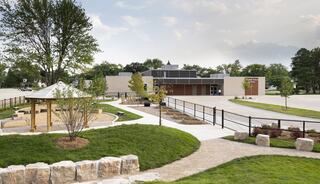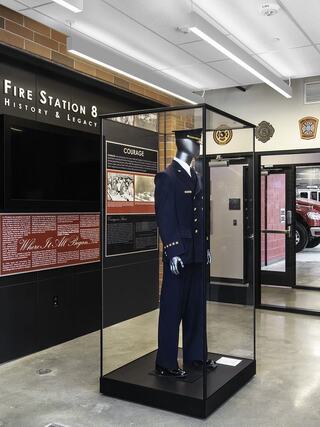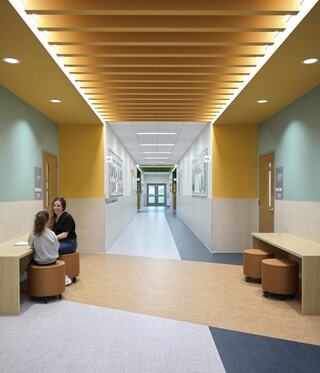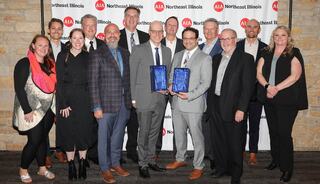
Creating Spaces for Neurodiverse Students
Published: 11.12.24
Author: Carol Stolt
Category: Design
Tags: Higher Education, Corporate, Recreation, Multifamily/Mixed-Use, Civic, PK-12, Faith-Based, Public Safety
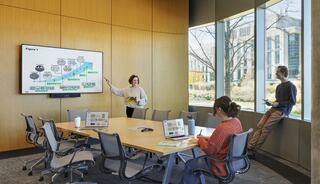
This article originally appeared in the July/August 2024 School Business Affairs magazine issue.
Strategies for changing the school’s physical environment to benefit special-needs students
Students have returned to the classroom after the pandemic, but the impact of COVID-19 on their learning is still evident. Students’ anxiety and depression are reported to be much higher than before the pandemic, and experts predict that trends will continue for generations to come.
If there is a silver lining to the challenges of the past several years, it is the awakening among administrators and educators about the needs of neurodiverse learners, a situation that existed long before the school year was disrupted by shutdowns and distancing.
Although curricula, teaching methods, and policies are being reexamined in light of this new awareness, it is also important to look at the physical learning environments to determine how built spaces can be attuned to better serve a broad spectrum of learners.
Neurodiverse individuals display brain structures, chemistry, or functioning that falls outside what is considered typical but should be considered normal. These students often exhibit exceptional strengths, talents, and skills, and under the right conditions, they will thrive in the classroom.
Accommodating the needs of neurodiverse students requires an understanding of how they experience and react to stimuli and interact with others and their surroundings. Given a space focused on engagement, safety, trust, and comfort, even those with significant challenges can make remarkable academic and social progress.
The Built Environment’s Impact on Learning
The homogenous, cookie-cutter approach to facility design in education leaves a surprisingly large segment of students behind. Although the National Center for Education Statistics reports that up to 20% of the population in the United States could be considered neurodiverse, the struggles of many of these individuals go unaddressed, either because they have not received a formal diagnosis or because schools have not been notified of their condition.
What is clear is that educators must serve every person on campus, students and faculty alike, in a way that respects their differences and allows them to reach their full potential. This objective can be accomplished, in part, by evaluating learning spaces in relation to operational and design accommodations.
From an operations standpoint, it is critical that the established procedures, processes, and standards have been reevaluated and adjusted in light of best practices and the most current understanding of how to best serve a neurodiverse population. This process begins by identifying and engaging students with special needs and making specific operational accommodations, such as flexible work and classroom schedules, breaks during assignments or exams, and alternate instructions to promote understanding.
A woman stands next to another woman sitting down, in a well-lit breakout room or lobby space. Flexible seating options and natural exposure to the outdoors have a calming, comforting effect on neurodiverse learners.
Design accommodations will require alterations to how spaces are structured and used, but they will not necessarily involve a significant financial investment. Natural light, exposure to the outdoors, and other biophilic elements have proved to have a calming and comforting effect that makes the mind more conducive to learning.
Lighting should be bright enough to accomplish the task at hand, but easily reduced for more contemplative exercises. Eliminating potentially abrasive or distracting stimuli will allow for better concentration; that includes insulating against sounds from the building’s mechanical systems. Measures to control odors from restrooms, cafeterias, and cleaning supplies or equipment must be taken on an individual basis.
It is also important that students have the option to remove themselves from the classroom when experiencing high levels of anxiety. A variety of quiet locations— including resource and sensory rooms and solitary spaces—will allow them to self-manage their emotions as they refocus and regenerate before rejoining their classmates.
Retreat areas can include equipment that will allow an individual to engage with a project or task, but resource and sensory rooms should be free of electronics and other distractions.
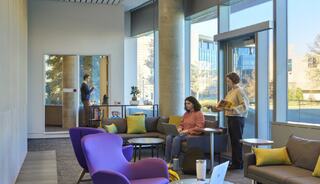
Self-Guided Learning
A man and woman sit next to one another at a conference table, with a TV screen on the far right wall and large unobstructed windows behind. Large windows offering views to natural light and the outdoors provides a relaxing environment for neurodiverse learners.
A classroom of students sitting rigidly in precise rows with their heads up and eyes fixed on the teacher was once considered the best setting for imparting and receiving knowledge. We now know that many of the individuals who do not flourish in such an environment are not the inevitable lower end of the bell curve but are simply not wired to thrive in such conditions.
Some students appear to listen better with their eyes closed or while gazing out a window. Allowing students to choose where to sit and to move around during a lecture can relieve stress. Providing students a choice in seating types lets them learn in a way that suits them. In general, barring rigid demands and maintaining a level of freedom in the classroom will yield positive results for all students, not just the neurodiverse.
No Best Way to Learn
The assumption that education requires a school building was challenged during the COVID-19 pandemic. The overriding lesson learned from shutdowns and remote learning is that online and hybrid learning should be an ongoing alternative and incorporated equitably into a school’s operations and curriculum.
Many students discovered that learning from home is more attuned to their abilities and preferences, but even with the widespread adoption of remote learning technology during the pandemic, those logging in from home are often at a disadvantage compared with their in-classroom peers.
These deficiencies can be addressed by moving beyond the single camera, single microphone setup that does not fully capture the sights and sounds of a lesson, lecture, or discussion. Microphones placed strategically throughout the room and voice-activated cameras that follow a teacher as he or she walks about the room or that cut to a student asking a question will allow for a much more immersive experience.
This in turn will make the remote learner feel more a part of the campus community and not just someone lurking about in cyberspace.
A Transformation
We are fortunate to have reached a point in history where segments of the population that have long been neglected in our educational systems are being recognized. As our understanding of the neurodiverse mind continues to evolve, we will continue to develop new and better ways to accommodate neurodiverse students and their unique strengths and weaknesses.
Those who conceive and design the spaces where people learn will play a pivotal role in that evolution, and that transformation must start today.
Carol Stolt is Design Principal with FGMA. Email: carolstolt@fgmarchitects.com
News & Insights
All Articles

A Shared Vision for Community: The Downers Grove Civic Center Redefines Collaboration and Sustainability
